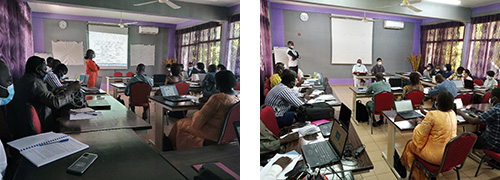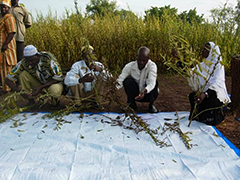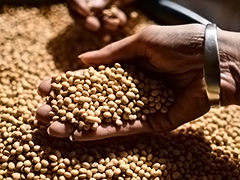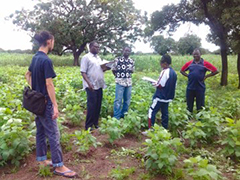Activities in Burkina Faso
Agriculture
I. The main lines of activities
The agricultural sector in Burkina Faso employs most of the workforce, making it an important pillar of the national economy.
However, it faces many challenges that need to be addressed urgently in order to modernize the sector and make Burkina Faso agriculture competitive, sustainable and resilient.
In this context, JICA provides support to the government of Burkina Faso through multifaceted interventions and primarily on the following axes:
- Improving productivity
- Promotion of agro-industry
- Construction of value chains
- Strengthening food security
II. Intervention methods
Activities in the field of agriculture are classified into four modalities:
- Technical cooperation projects
- Donations
- Initiatives aimed at boosting the sector
- Partnership with the private sector.
III. Current projects
1- Project on establishment of the model for fertilizing cultivation promotion using Burkina Faso phosphate rock in Burkina Faso (SATREPS, 2017-2023)
1) Implementation period : May 2017 to April 2023
The Project was initially planned for a period of 5 years, but it has been extended to 2023 due to a delay in activities caused by the Covid19 pandemic.
2) Outline of the project
- Overall goal: Either a part or all of the components of the "model for fertilizing cultivation promotion" is/are adopted for technical application and dissemination by the Ministry of Agriculture, Hydro-agricultural development and mechanization (MAAHM).
- Specific objective: An applicable "model for fertilizing cultivation promotion" with use of Burkina Faso phosphate rock (BPR) is established in consultation with Ministry of Agriculture and Hydraulic Layouts (MAAH) and other stakeholders.
- Expected outputs:
- The formula of regionally adapted NPK (Fertilizer is a combination of NPK or nitrogen (N), phosphorus (P), and potassium (K)) compound fertilizer using BPR is developed.
- The method of new NPK compound fertilizer use adoptable by farmers is established.
- A technical paper for BPR direct application method is submitted to the National Center for Scientific and Technological Research (CNRST) for approval.
- A strategy for efficient BPR use is formulated.
- Activities
- Conduct the baseline survey to clarify the current situation.
- Identify the chemically and economically optimum treatment for calcinated phosphate fertilizer.
- Develop the inventory of African phosphate rocks with chemical, physical and mineralogical properties.
- Develop efficient fertilizer application methods whether made only with the phosphate rock for direct application or in combination with other components on various crops and under various agro-ecological zones.
- Simulate the economic impacts of promotion of fertilizer and/or phosphate rock direct utilization at households and national levels.
3) Implementing agency
It is placed under the technical supervision of the Ministry of Higher Education, Scientific Research and Innovation, and the financial supervision of the Ministry of the Economy, Finance and Development. The implementing structure is the Environmental Institute for Agricultural Research in Burkina Faso (INERA)
The Ministry of Agriculture, Hydraulic development and mechanization (MAAHM) plays a role as a partner agency for adoption and utilization of the Project outputs.
4) Areas of intervention
Center (Ouagadougou), Center-West (Saria), West (Farako-ba) and East (Kouaré) regions.
5) Target Target groups
The scientific community and farmers
 Electric rotary kiln acquired under the project for the treatment of phosphate used for testing
Electric rotary kiln acquired under the project for the treatment of phosphate used for testing
 Solar platform providing the energy necessary for the Kiln operation
Solar platform providing the energy necessary for the Kiln operation
 Tests set up to assess the effect of Burkina's phosphates on the productivity of sorghum (a) and cowpea (b)
Tests set up to assess the effect of Burkina's phosphates on the productivity of sorghum (a) and cowpea (b)
2- Project for the Improvement of the Nutritional Situation through Agriculture (PASNA, 2021-2025)
1) Project period
The implementation is planned over a period of 5 years from January 2021 to December 2025. The official kick-off took place in March 2021.
 The actors of the Project during the kick-off meeting
The actors of the Project during the kick-off meeting
 Kick-off work view
Kick-off work view
2) Outline of the project
- Overall objective: An increased number of cases of behavioral changes and other necessary measures related to improved nutrition are observed in the target regions
- Specific objectives: Behavior changes and other necessary measures related to improved nutrition are observed at the pilot sites.
- Expected outcomes:
- The Logical Framework is updated through a detailed survey during the planning phase.
- The intervention strategy on school meals by promoting agriculture is defined by the three ministries of the concerned sectors: Ministry in charge of agriculture,, Ministry in charge of education and Ministry in charge of health.
- The income of target producers increases through the implementation of the SHEP (Smallholder Market Gardening Empowerment Approach).
- The community multisectoral model for improving nutrition is put into practice
- The multisectoral model in schools for improving nutrition is put into practice
- Activities: They will take place in two phases as follows.
For the pilot phase (planning phase)- Activities related to market-oriented agriculture
- Activities related to improving nutrition
- Activities related to the improvement of nutrition
- Activities related to the school canteen
- Baseline survey for the target geographic area.
- Scaling-up activities will be planned based on the results of the pilot phase
3) Implementing agency
The projects is placed under the technical supervision of the Ministry in charge of agriculture and the financial supervision of the Ministry of the Economy, Finance and Development.
Given its multisectoral nature, the ministries in charge of education and health are the main stakeholders for its implementation.
4) Areas of intervention
The Project covers the regions of Center, Boucle du Mouhoun, South-West, Sahel, East and Center-South.
5) Target groups
The direct beneficiaries of the project are estimated at 7,700 people including pupils of primary schools, teachers, agricultural households (1,350 households) whose children are enrolled in pilot schools in Ouagadougou and in the target regions, as well as children under 5, pregnant and lactating women from agricultural and non-agricultural households in the target areas.
3- Other support approaches
JICA's support in Burkina Faso is also done through technical assistance from Japanese experts in various fields as well as the implementation of initiatives targeting specific sectors.
1) Technical advisor: Technical advisor is assigned at the General Secretariat (SG) of the Ministry of Agriculture and Hydraulic Development (MAAHM) where he provides technical assistance.
Technical advisor's mission mainly involves the following points:
- Identify and analyze the context and challenges in the rural sector in Burkina Faso
- Provide advisory support to the MAAHM on the orientations of Japanese cooperation as well as international activities carried out by japan in Burkina Faso
- Provide support for the formulation of policies and a support to the SG when needed in various areas of competence of the MAAHM
2) Initiatives
(1) CARD: the Coalition for African Rice Development (CARD) was launched in 2008 on the margins of the fourth Tokyo International Conference on African Development (TICAD IV). CARD has 23 member countries including Burkina Faso. Since its creation, it has supported the efforts of African countries to double the production of rice in Africa over a period of ten years, with the objective of closing the gap between supply and demand, and contributing to the achievement of food security and poverty reduction in the continent.
The first phase (2008-2018) made it possible to record satisfactory results, which needs to be consolidated with more efforts which are being done in the framework of the second phase which also aims to double rice production by 2030.
In Burkina Faso, CARD actions focus on the development of rice sector policies, on capacity building of actors in the sector. An increased investment through the creation of a favorable environment has recently led to the preparation of the second generation of the National Rice Development Strategy (SNDR II). This document constitutes the unique frame of reference for rice sector development interventions in the country.
(2) SHEP: The marketing of horticultural products in Burkina Faso is one of the main challenges of the agricultural sector. In order to meet this challenge, SHEP initiative has been proposed by JICA in 2015. The Smallholder Horticulture Empowerment and Promotion (SHEP) is an initiative that promotes market-oriented agriculture with the aim of raising the income level of smallholder farmers in Africa. SHEP aims to make agriculture a business ("strategically produce to sell" and not "produce and sell") and to better connect the producer to the market.
In view of the satisfactory results of SHEP in Kenya, JICA decided to extend it to several other African countries and make it a pillar of its cooperation in the field of agriculture.
In Burkina Faso, about 400 MAAHM agents have been trained on the SHEP approach through capacity building programs in Japan, Kenya and in Burkina Faso. Apart from the extension officers of the MAAHM, the SHEP approach also targets the Multi-purpose agricultural center (CAP) of Matourkou. Hence, its agents also benefit from training on the SHEP approach, the intention being to bring this tool to CAP students, who are the future SHEP extension agents.
 Extension workers being trained on the approach
Extension workers being trained on the approach
 Market survey by extension agents
Market survey by extension agents
(3) IFNA: In Burkina Faso, various nutritional surveys (SMART [1], EDS [2]) indicated that the nutritional situation remains worrying despite the progress observed over the past ten years. These include the high prevalence of acute malnutrition and chronic malnutrition, particularly among children under five. In order to find a long-term solution to this situation, JICA is making its contribution through the Initiative for Food and Nutrition Security in Africa (IFNA). IFNA has 11 member countries and aims to support the efforts of each government in accelerating the implementation of their food security and nutrition policies.
Its implementation in Burkina Faso since 2015 has led to the development and validation of an action strategy for the country (ICSA). This country strategy takes into account the North, Center-West and South-West regions where a package of actions involving actors from the agriculture, education and health sectors will be implemented to fight against malnutrition through a preventive approach based on the production and consumption of local agricultural products according to the priority nutrition problems identified by national surveys.
 IFNA actors during the ICSA Project Concept Formulation workshop in October 2021
IFNA actors during the ICSA Project Concept Formulation workshop in October 2021
3) Capacity building
- The knowledge co-creation program (short-term internships) has allowed the training of many MAAHM agents in Japan and in third countries on various themes.
- Long-term training programs offer the possibility of obtaining a master's or doctorate from a Japanese university. The programs include:
- Agriculture studies networks for food security (Agri-Net): it gives the opportunity to obtain a Masters or Doctorate degree for workers in the public sector (or related private sector organizations) working for stable food production.
- SDG's Global Leadership Program "Training leaders to achieve the SDGs": it gives the opportunity for a Masters or Doctorate degree for public and academic sector workers who contribute to their countries' policy-making and socio-economic development.
- African Business Education Initiative for Youth (ABE Initiative): it gives the opportunity for a Master's degree and a business internship in order to train future contributors to the development of African industry and the activities of Japanese companies in Africa.
- The development of human resources in the public and private sectors in areas related to agriculture and rural development policy, sustainable agricultural production, development of marine resources / fisheries, food value chains and to nature conservation
- Strengthening of a human network between developing countries and Japan in the aforementioned areas.
IV. Achievements of Japanese past cooperation in the field of agriculture
1- The project for improvement of food productivity and household income through the creation and promotion of reference sites (2014-2019)
This project was implemented in the province of Bam, which is a very important agro-pastoral zone in Burkina Faso. The area is characterized by weathered soils due to the double action of wind and water erosion. This soil condition, which leads to a drop in agricultural yields, is not favorable for the food security of the populations. In such a context, it was urgent to take measures to recover weathered soils in order to improve agricultural productivity and the economy of households. JICA therefore provided its support with implementation of this project with the aim of contributing to the socio-economic development of the population through environmental protection and consolidation of food security.
The main objective was the improvement of agricultural soils and sheep fattening in favour of the beneficiaries (farmers and breeders in the area). The project targetted three (03) villages of the province of Bam (North central region) namely Tamponga, Yalka and Foulou. The number of registered beneficiaries is 135 households at the rate of 45 households per village. The project was implemented between the Japanese Non-Governmental Organization (NGO) "Action for Greening Sahel (AGS-Japan) and the Burkinabè NGO" Association des Jeunes pour la Protection de l'Environnement et l'Elevage "(AJPEE ) with the support of JICA.
The achievements are:
- A significant improvement in agricultural productivity: agricultural yield increased from 30% (before the project) to 50% at the end of the project following recovery of the weathered land through construction of bunds and Zaï, composting practices, and reforestation by the Assisted Natural Regeneration (RNA) method.
- Improvement of economy and household income level through income-generating activities around sheep fattening and the promotion and valuation of non-timber forest products (especially shea tree)
- The three (03) beneficiary villages were equipped with a shea-almond oil extraction machine and a solar installation to facilitate lighting of the processing unit.
- Women also produce soap from the extracted oil, which they sell to diversify their sources of income
- The profit margin recorded by each of the beneficiaries has been doubled
These actions aiming at creating and diversifying income sources have enabled beneficiaries to generate benefits that have contributed to meeting needs related to health, schooling as well as those related to agricultural production equipment and inputs.
- Improvement of economy and household income level through income-generating activities
Improving the food situation: Significant reduction in the length of the lean season.
Before the Project, the stock used to be exhausted approximately 4-7 months after harvest for all villages. After the project, the durations are 7 to 9 months for Tamponga, 4 to 9 months for Yalka and 4 to 8 months for Foulou. - Capacity building of beneficiaries as well as of the AJPEE association for the sustainability of the Project effects
 Collection of rubble by the community
Collection of rubble by the community
 Construction of diguette by the community
Construction of diguette by the community
 Diguette development in Yalka
Diguette development in Yalka
 Sheeps donated to women inTamponga
Sheeps donated to women inTamponga
 Zai activities in Tamponga
Zai activities in Tamponga
 millet harvest
millet harvest
 Shea Nut Oil Press
Shea Nut Oil Press
 Manufacture of liquid and solid soap by women
Manufacture of liquid and solid soap by women
2- Study Project for the Formulation of a National Lowland Development Program (PE-PNDBF, 2017-2019)
Study Project for the Formulation of a National Lowland Development Program (PE-PNDBF, 2017-2019)
- A GIS database of lowlands throughout the territory has been created and servers installed in the General direction or hydraulic development (DGAHDI) and in the IT department of the Ministry in charge of agriculture. The database can be updated when new events happen on lowland.
- A national lowland development program has been formulated.
3- Project for reinforcement of sesame production in Burkina Faso (PRPS-BF, 2014-2021)
 White (a) and black (b) sesame seeds
White (a) and black (b) sesame seeds
The main achievements of the project are as follows:
- Capacity building of 342 core producers on the technical routes of sesame production
- Registration of 151 producers on the registers of seed producers
- Selection of three new varieties of sesame (Bo-Nogora, Pakre Saya, A kilom) and inclusion of these in the national seed catalog
- Support for the development and dissemination of specifications on the marketing and even exportation of sesame
- Development of a manual of production techniques for certified sesame seeds in Burkina Faso
- Development of an illustrated manual for the production of certified sesame seeds
- Development of a sesame production extension manual: PRPS-BF approach
Photos of some Project activities
 Capacity building of producers (a) et (b)
Capacity building of producers (a) et (b)
 View of a sesame farm in the the Boucle du Mouhoun area (a) and weeding/hoeing activity by producers (b)
View of a sesame farm in the the Boucle du Mouhoun area (a) and weeding/hoeing activity by producers (b)
 Sesame post-harvest processing
Sesame post-harvest processing
4- Capacity building project for actors in the soybean value chain (October 2017 to December 2018)
 Soybean seeds
Soybean seeds
- Soy bean sector structuring :
Center-East / East- 42 technical officers and 12 producers trained,
- Support for the establishment of 79 soybean producers' cooperatives (2,387 people)
- Support for the establishment of soybean producers' cooperatives (12 cooperatives and 5 groups) in the Kompienga area
- Support for the establishment of 1 soybean processors' cooperatives (composed of 5 companies of Bobo Dioulasso,), 7 soybean producers' cooperatives and 1 seed production cooperative in Houndé.
- Awareness on the contractualization between soybean producers and processors (15 soybean producers, 10 processors, and 3 members of the Provincial Union of agricultural professionals (UPPA) of Kenedogou)
- Soybean producers identification in the Kenedougou area (896 producers identified with intentions to sell 1,590 of soybean tons)
- Support by linking buyers and producers (B2B) (In total 105 interviews carried out between 07 buyers and 15 soybean groups to facilitate contractualization for the 2018-2019 campaign)
- Support for the structuring of soybean producers (19 cooperatives creation in Diebougou)
- Capacity building in the soybean sector :
Hauts bassins- Support by promoting relations between cooperatives and funding structures (via B2B meetings) in Bobo Dioulasso
- Establishment of farmers field schools: 15 sites in the Center-east region, and 3 sites in the East region. 450 producers were trained.
- Support by promoting relations between producers and 1 seed-producer: producers from 4 municipalities took part to the activity and the seed-producer received request for 18 tons of seedlings in the Koupelogo area.
- Capacity building on harvesting and post-harvesting techniques : farmers from 4 municipalities of the Koulpelogo area took part
- Monitoring of the soybean production cost : 18 sites of the farmers field schools benefited
- Organization of multi-stakeholders B2B meetings :
Hauts bassins- B2B for Producers identified in the Kénédougou department gathering 896 producers, who expressed their intention to sell 1,590 tonnes of soybeans to processors from Bobo Dioulasso.
- Out of a total quantity of 1,541 Tons of soybeans offered to buyers, producers and buyers have succeeded in concluding the marketing of 628 Tons (41%) and 859 Tons discussed after the meeting.
- B2B 3,365 producers and 1 seed supplier took part. In total 2,152 Tons of soybean in the Kompienga area;
- Capacity building on hasvesting and post-harvesting techniques: producers from 4 municipalities of the Koupelogo area took part.
- Establishing links between producers and a seed supplier: 4 municipalities for a quantity of 18T of seed in the Koupelogo
- Training of producers on harvesting and post-harvest techniques: 4 municipalities in the Koulpelogo
- Monitoring of soybean production costs: 18 sites benefiting from CEP
- Promotion of small activities on soybean processing:
- A national soybean forum organized in May 2018 in Ouagadougou involving concerned stakeholders from the education, agriculture and health sectors.
- Pilot project between JICA, MENAPLN and MAAHM :
- 4 schools were supported by capacity building on soybean production, processing and consumption
- Training on the production of enriched soy flour: 8 municipalities including 40 soybean producers trained in the Center-East region and 10 processors from Kénédougou
Images of a few activities of the Project
 Experimental plot showing the difference between a traditional production (left) and a technology option production (right)
Experimental plot showing the difference between a traditional production (left) and a technology option production (right) Presentation of the data sheet on soybean production by a producer in the Bitou area during a follow-up survey of the agricultural season
Presentation of the data sheet on soybean production by a producer in the Bitou area during a follow-up survey of the agricultural season
 Monitoring mission in a school farm for soybean production at Ouroubonon in the Balé province
Monitoring mission in a school farm for soybean production at Ouroubonon in the Balé province Monitoring mission in a school farm for soybean production at lapara in the Balé province
Monitoring mission in a school farm for soybean production at lapara in the Balé province
 Training of canteen's staff of Danfina (a) and Mano B (b) (in the Sissili province) schools on soybean processing technology
Training of canteen's staff of Danfina (a) and Mano B (b) (in the Sissili province) schools on soybean processing technology Preparation of soy skewers with processors from the Yu SONI association (a, b, c)
Preparation of soy skewers with processors from the Yu SONI association (a, b, c)

- Asia
- Oceania
- Latin America
- Africa
- Angola
- Benin
- Botswana
- Burkina Faso
- Burundi
- Cameroon
- Comoros
- Côte d'Ivoire
- Democratic Republic of the Congo
- Djibouti
- Eritrea
- Ethiopia
- Gabon
- Ghana
- Kenya
- Liberia
- Madagascar
- Malawi
- Mauritius
- Mozambique
- Namibia
- Niger
- Nigeria
- Rwanda
- Senegal
- Seychelles
- Sierra Leone
- Somalia
- South Africa
- South Sudan
- Sudan
- Tanzania
- Uganda
- Zambia
- Zimbabwe
- Middle East
- Europe
- About JICA
- News & Features
- Countries & Regions
- Our Work
- Thematic Issues
- Types of Assistance
- Partnerships with Other Development Partners
- Climate Change / Environmental and Social Considerations
- Evaluations
- Compliance and Anti-corruption
- Science and Technology Cooperation on Global Issues
- Research
- JICA Development Studies Program / JICA Chair
- Support for the Acceptance of Foreign HRs / Multicultural and Inclusive Community
- Publications
- Investor Relations
